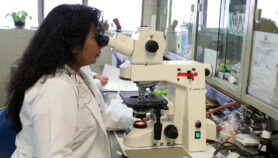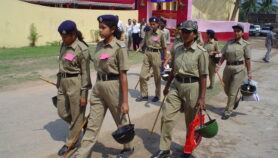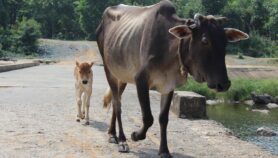By: Ranjit Devraj
Send to a friend
The details you provide on this page will not be used to send unsolicited email, and will not be sold to a 3rd party. See privacy policy.
[NEW DELHI] India’s scientists are beginning to resist the systematic way in which the country’s most prestigious annual science event, the Indian Science Congress (ISC), has been used in recent years to promote Hindu mythology and pseudoscience by the political leadership.
Prime Minister Narendra Modi, who leads the pro-Hindu nationalist Bharatiya Janata Party, set the trend soon after he took office in 2014. He declared that the mythical warrior god Karna, whose gestation and birth were supposed to have taken place outside his mother’s womb, proved that ancient India possessed advanced medical technology.
Since then, Modi’s cabinet, academics and politically motivated scientists have been trying to outdo each other to prove that Hindu religious mythology is evidence of a lost age when science and technology were supposed to have been more advanced in India than anywhere else in the world. The annual science congresses provided them just the opportunity to air their obscurantist beliefs.
“Resistance is now building up, especially among young scientists, to concerted attempts to dumb down one of the world’s major scientific gatherings just to suit political ends.”
S. Faizi
If speakers at successive science congresses were to be believed, these are the facts: India possessed aeroplane technology 2,000 years ago, genetic engineering was first developed in this country, as were theories of relativity. By 2016, the Nobel prize-winning structural biologist Venkatraman Ramakrishnan was describing the ISC as a “circus” and swore never to attend another one because of its politicisation.
But such strong criticism from a Nobel laureate was lost on the top managers of the event. At the 2018 event, Harsh Vardhan, minister for science and technology and a medical doctor, made the wild claim that advanced mathematical principles were stolen from India by the ancient Greeks. He also misquoted Stephen Hawking as saying that the Vedas (India’s sacred texts) contained theories of relativity more profound than Einstein’s.
Another top politician, Satya Pal Singh, junior minister for human resources development, took on Charles Darwin’s theory of evolution and ordered it removed from textbooks. His argument? “None of our ancestors have recorded seeing an ape turn into a man.”
“All this might have been laughable as the rants of unscrupulous politicians, but there is an organised pattern in this deliberate promotion of pseudoscience,” says S. Faizi, an eminent ecologist who presented a paper on forest management at this year’s science congress held in Jalandhar, Punjab state.
At the 106th science congress (3 to 7 January), the vice-chancellor of the Andhra University, Nageshwar Rao, said a theory had already been doing the rounds in ruling party-controlled social media for some months—it claimed that the Kauravas, who figure in Mahabharata, the ancient Indian epic, were created using stem cell technology.. “He was only giving voice at the science congress to an outrageous theory that stem cell technology existed in ancient India,” Faizi said.
Rao, a biologist, harped on another favourite Hindu myth — that the waters of the sacred river Ganges were capable of healing and purifying body and soul, even in its heavily polluted state. “Ganges water has been scientifically proven to fight infection because it has bacteriophages that kill harmful pathogens.”
Faizi tells SciDev.Net that the pseudoscience culture has so taken root that, at his own presentation, he had to take extra care to “differentiate between bona fide traditional knowledge related to biodiversity and outlandish claims to link it to modern scientific discoveries”.
Faizi notes, however, that large sections of his audience were keenly aware of attempts to foist pseudoscience on to them and were receptive to the need to protect the integrity and decorum of the ISC. “Resistance is now building up, especially among young scientists, to concerted attempts to dumb down one of the world’s major scientific gatherings just to suit political ends.”
The Andhra University vice-chancellor’s exertions did not go unchallenged. K. VijayRaghavan, principal scientific advisor to the government, no less, took to social media to demand action against him.
“It is unfortunate that the sitting vice-chancellor of a great state university — and a biologist, to boot — says something that is scientifically, completely untenable,” he wrote. “His chancellor should receive a formal complaint from those who were present in the audience and he will surely hear from individual scientists and our vocal science academies.”
VijayRaghavan suggests in the blog how best to deal with India’s pseudoscience problem. “When lay people, including politicians, make random and erroneous statements linking religion, culture, history, etc. to science, the problem must be addressed by collegial communication. When scientists make such links, they should be addressed more squarely.”
“Sadly, VijayRaghavan’s is a rare voice in the government on this twin desecration of science and mythology,” says Faizi. The net result, he says, is loss of credibility for Indian science, modern as well as ancient.
That is no exaggeration. Madhavan Nair, former chairman of the Indian Space Research Organisation, was met with incredulity when he said back in 2015 that the fifth-century Indian astronomer Aryabhata had described gravity well before Newton. But, in fact, Aryabhatiya, a text written by Aryabhata, describes the earth’s rotation and gravity and explains such phenomena as lunar and solar eclipses.
Other academics believe that the dangers from pseudoscience are exaggerated. “It is a free country and everyone is free to hold whatever views he or she wishes,” says M. Rajivlochan, a professor at the Panjab University and a member of the State Higher Education Council.“What is important is that we train our students early to distinguish between competing viewpoints. Which means making them familiar with scientific methods of reality testing, including the limits of the scientific method. [They must also be taught] to not get stressed out [when they discover] that the wisdom dished out by their betters, elders and superiors can be so much bullshit,” Rajivlochan tells SciDev.Net.
This piece was produced by SciDev.Net’s Asia & Pacific desk.














